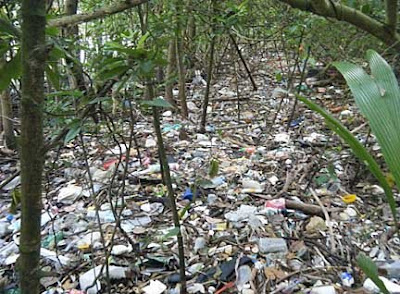 Adam Pasick shared about these photos taken by Chris Jordan who told a sobering tale of his journey to Midway Atoll with the Poptech conference.
Adam Pasick shared about these photos taken by Chris Jordan who told a sobering tale of his journey to Midway Atoll with the Poptech conference.According to Chris Jordan: The nesting babies are fed bellies-full of plastic by their parents, who soar out over the vast polluted ocean collecting what looks to them like food to bring back to their young.
 On this diet of human trash, every year tens of thousands of albatross chicks die on Midway from starvation, toxicity, and choking.
On this diet of human trash, every year tens of thousands of albatross chicks die on Midway from starvation, toxicity, and choking. The amount of plastic objects that we are finding inside of the albatross carcasses that cover Midway Island is so shocking that it might be hard to believe, say the photographers who documented the dead chicks.
The amount of plastic objects that we are finding inside of the albatross carcasses that cover Midway Island is so shocking that it might be hard to believe, say the photographers who documented the dead chicks. The photographers followed strict ethics in taking the photos: no adding and no removing, among others.
The photographers followed strict ethics in taking the photos: no adding and no removing, among others. The plastics include everyday objects improperly disposed without thought.
The plastics include everyday objects improperly disposed without thought. Death by bottle caps.
Death by bottle caps. Death by fishing line.
Death by fishing line. Where does this plastic trash come from? Plastic does not decompose quickly and can remain intact for 100 years. So the plastic could come from anywhere and everywhere.
Where does this plastic trash come from? Plastic does not decompose quickly and can remain intact for 100 years. So the plastic could come from anywhere and everywhere. Here's some plastic debris seen on Singapore shores.
Here's some plastic debris seen on Singapore shores.You CAN make a difference
- Use less. REDUCE is the first of the 3Rs that is often overlooked.
- Dispose of trash properly. A bottle cap tossed on the road gets washed into a drain, into a canal then into the sea where in the next 100 years could end up inside a seabird chick.
- Encourage others to do the same.
- Join International Coastal Cleanup Singapore to learn more and do more about marine debris.
Links
Midway Five media artists, led by photographer Chris Jordan, traveled to Midway Atoll National Wildlife Refuge to witness the catastrophic effect of our disposable culture. Includes videoclips, facebook, flickr and other links.
See also Dining Out In An Ocean Of Plastic: How Foraging Albatrosses Put Plastic On The Menu ScienceDaily 27 Oct 09;
More information
- Latest media articles about marine debris on the wildsingapore news blog
- News from International Coastal Cleanup Singapore
- Posts about marine litter on this blog.



